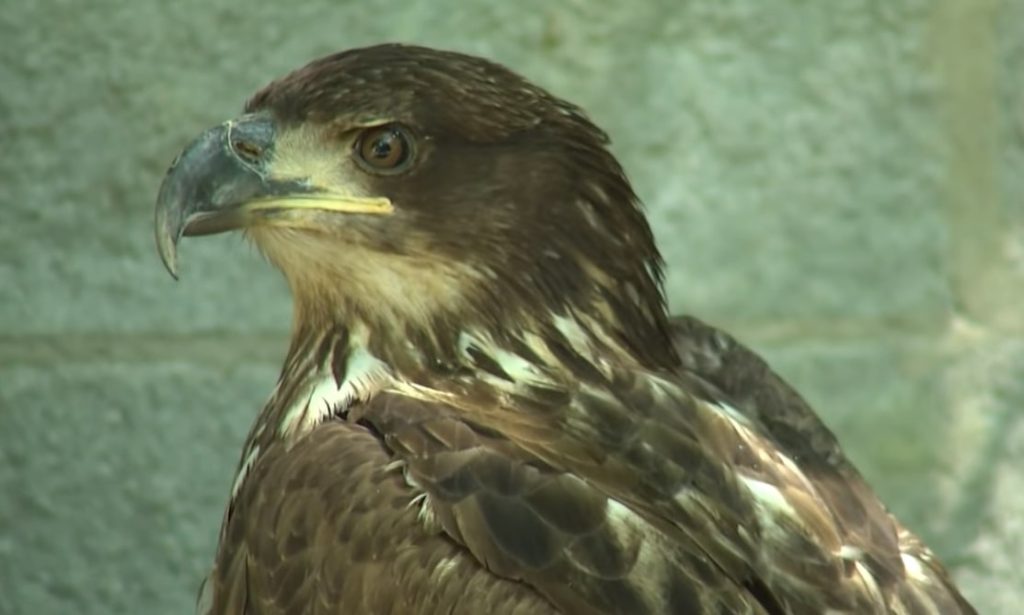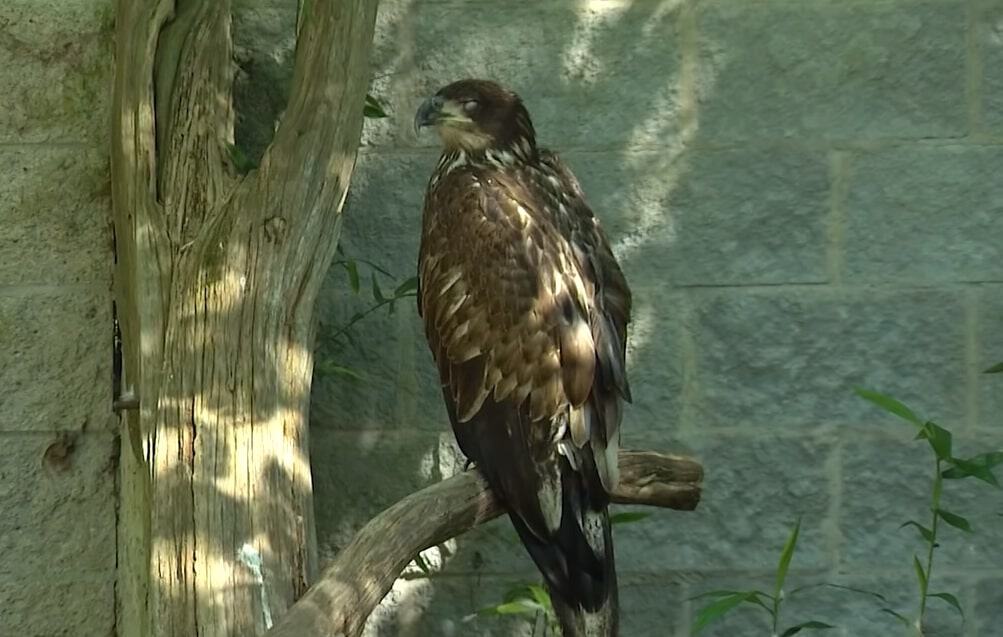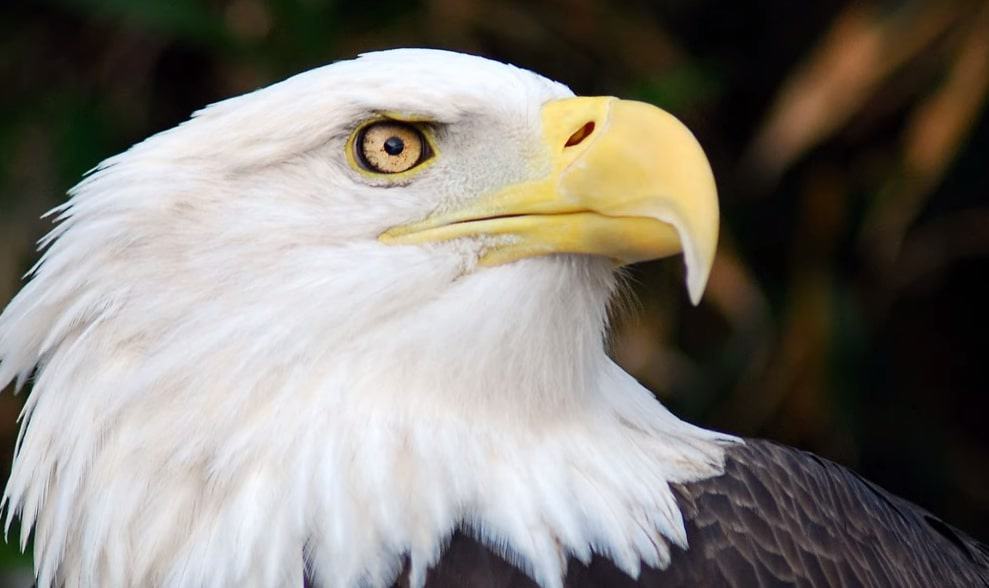The Bald Eagle, America’s symbol of freedom, really stands out, doesn’t it? It flies high in the sky with its big wings, showing off its wild spirit. Although, they are known for their big size and amazing hunting skills, what’s more interesting is how they start out fledging.
At this point, the bird is all set to leave the nest, start flying, and gradually learn to fend for itself. They are basically on the brink of discovering the world for themselves.
Let’s dive into the lives of these fledgling eagles as they navigate their path to adulthood.
Why Are Juvenile Bald Eagles Bigger Than Adults?

The size difference is due to their rapid growth rate in their early years. Additionally, juveniles get better nutrition than adults because they still rely (at least partially) on their parents for food. This strategy facilitates optimal growth conditions.
I see it this way: Adult Bald Eagles must hunt to fend for themselves. This means they spend a lot of energy looking for food instead of growing in size. They also share some food with their offspring, reducing availability.
On the other hand, juveniles get their food primarily from their parents. There is a lot more food available to them and a lower energy cost.
Of course, genetics and environmental factors will also impact their growth. I’ve seen eagles that show signs of stunted growth because less food was available to them due to competition with other species. Despite all these obstacles, juveniles are generally more sizable than their parents.
Juvenile Eagles by Age
By now, you’re probably interested in discovering how young eagles develop into adulthood. They’re often mistaken for golden eagles in these transitory stages, especially since their characteristic white head is still not formed.
Let’s explore the growth trajectory of juvenile Bald Eagles as they progress through different stages of development:
Juvenile to 1 1/2 Years

In my opinion, this stage is a critical transition for young eagles as they begin to adapt to living outside of the only home they’ve known so far–the nest.
Although they still depend on their parents for food, they are quickly gaining confidence in their flight skills.
Juveniles also undergo massive changes in their appearance during this time. Their mottled plumage slowly gets more dark brown, and the beginnings of the white feathers around their heads appear.
It amazes me how much their wingspan increases as their robust bodies grow rapidly during this period.
2 1/2 Years
By this age, juveniles have significantly refined their flying and hunting skills. I know many people who tend to mistake juveniles for adult Bald Eagles at this stage because they resemble them in appearance and behavior.
Yet, there are still some markets of immaturity that are obvious to the keen and trained eye.
Physically, their plumage still shows some mottle patterns, but it is gradually fading away as they mature. Growth rates slow down, but they are still developing their wingspans.
Juveniles also show some characteristic behaviors that set them apart from adults. I’ve seen them act more playful and they have always felt a little clumsy (especially in flight).
They still eat the same food, but they are less reliant on their parents for nutrition at this stage. Instead, they exhibit more proficient hunting techniques as they gain more confidence and experience.
3 1/2 Years
At this stage, the juvenile eagle is well on its way to adulthood. Its wingspans and other dimensions are now closer to their adult size, with some variation depending on environmental factors and genetics.
As you’d expect, its plumage gradually loses the mottling, and the white head becomes more prominent as it ages.
Whenever I’ve seen eagles this age, I notice their behavior is much more mature. Juveniles at the 3 1/2-year mark show more independence and autonomy.
I’ve often noticed that they venture further away from the nest as they search for food and practice hunting. Their interaction with their parents is also significantly reduced.
4 1/2 Years to 5 1/2 or Definitive
In their final stages of maturation, juveniles get their definitive adult plumage. Slowly but surely, they lose the remaining traces of their juvenile appearance as they become adults.
At this point, their wingspans and body size should have already reached adult dimensions. Even their behavior has changed significantly. They are already agile hunters and have mastered the art of flight. They are practically independent at this point.
I’ve seen many Bald Eagles of this age start actively participating in breeding and nesting behaviors, showing they are ready to become definitive adults.
This is the stage of their life that watching them gets more exciting. They are more interactive, often engaging in courtship display and mate selection rituals. If you catch them in a spiral mating ritual, you’re lucky!
What Does the Underside of a Juvenile Eagle Look Like?
By now, you already know that the plumage of a juvenile Bald Eagle is constantly changing. It is actively transitioning from the mottled pattern to the sleek brown and white iconic look of the adult.
You can expect to see white patches on the wings and tails and a mottled pattern that the eagle loses with each successive molting.
The mottled look serves a protective purpose because it allows the juveniles to be camouflaged in their surroundings. Also, I’ve read that the white patches have more practical purposes.
This includes communication during flights, which is important as they provide visual cues to other nearby eagles. They also help thermoregulation, as the white patches reflect sunlight and reduce heat absorption.
Do Juvenile Eagles Migrate?
Juvenile Bald Eagles exhibit diverse migratory patterns, varying depending on geographic location, food availability, and environmental conditions.
While some juveniles remain in their natal areas year-round, others undertake long-distance migrations to more favorable wintering grounds.
Migration behavior among juvenile Bald Eagles is influenced by their reliance on food sources such as fish, which may become scarce in colder climates during the winter months. As a result, many juveniles from northern regions migrate southward in search of open water and abundant prey.
In contrast, juveniles from warmer climates with ample food resources may exhibit sedentary behavior, remaining in their natal areas throughout the year.
Additionally, some juvenile eagles may exhibit partial migration, with only a portion of the population undertaking migratory journeys while others remain resident.
Do Juvenile Eagles Ever Stay With Their Parents?
Juvenile Bald Eagles typically leave the nest and become independent within the first few months of fledging.
However, they may occasionally return to their parents’ territory for short periods, especially during their early years of independence.
This behavior, known as “reverse dispersal,” allows young eagles to familiarize themselves with their natal habitat and learn valuable survival skills from experienced adults.
During these temporary returns, juvenile eagles may interact with their parents, siblings, or other members of the parental pair. They may also benefit from shared food resources and protection within the familiar territory.
However, as they mature and gain confidence in their abilities, juvenile eagles gradually disperse and establish their territories.
While reverse dispersal is relatively common among juvenile Bald Eagles, the duration and frequency of these returns vary among individuals.
Some juveniles may stay with their parents for a few weeks or months before venturing out on their own, while others may remain close to their natal territory for longer periods.
What Color Are Juvenile Bald Eagles’ Eyes?

Juvenile Bald Eagles are easily distinguished by their striking light-colored eyes, which typically range from a pale yellow to a brownish-yellow hue. This distinctive eye color sets them apart from adult Bald Eagles, whose eyes are a vibrant, piercing yellow.
The lighter coloration of juvenile eagle eyes results from their age and developmental stage. As eagles mature, their eye color gradually darkens, eventually reaching the intense yellow characteristic of adults.
This transition in eye coloration reflects the bird’s progression from juvenile to adult plumage and accompanies other physical and behavioral changes associated with maturity.
While they are intriguing, variations in eye color have a more functional purpose. Lighter-colored eyes enhance camouflage and stealth during hunting and foraging, allowing juvenile eagles to blend more effectively with their surroundings.
Additionally, eye color may play a role in communication and social interactions among eagles, conveying subtle cues and signals during interactions with conspecifics.
Final Thoughts
As you can see, juvenile Bald Eagles undergo a remarkable transformation during their journey to adulthood. They experience rapid growth and stunning plumage changes that are awesome to observe.

